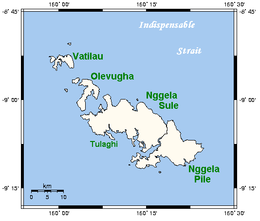
The Guadalcanal campaign, also known as the Battle of Guadalcanal and codenamed Operation Watchtower by American forces, was a military campaign fought between 7 August 1942 and 9 February 1943 on and around the island of Guadalcanal in the Pacific theater of World War II. It was the first major land offensive by Allied forces against the Empire of Japan.

Tulagi, less commonly known as Tulaghi, is a small island in Solomon Islands, just off the south coast of Ngella Sule. The town of the same name on the island was the capital of the British Solomon Islands Protectorate from 1896 to 1942 and is today the capital of the Central Province. The capital of what is now the state of Solomon Islands moved to Honiara, Guadalcanal, after World War II.

Purvis Bay is located in the Nggela Islands, part of the Solomon Islands. Purvis Bay is the sheltered area to the south of the island Nggela Sule, including and trending southeast from the neighbouring Tulagi islet.

USS Monssen (DD-436), a Gleaves-class destroyer, was the first ship of the United States Navy to be named for Mons Monssen, who was awarded the Medal of Honor for his actions aboard USS Missouri (BB-11) in 1904. Commissioned in 1941, the destroyer saw service during World War II in both Atlantic and Pacific Oceans. Monssen was sunk at the Naval Battle of Guadalcanal on 13 November 1942.
Gavutu is a small islet in the Central Province of Solomon Islands, some 500 metres in length. It is one of the Nggela Islands.

The Solomon Islands campaign was a major campaign of the Pacific War of World War II. The campaign began with Japanese landings and capture of several areas in the British Solomon Islands and Bougainville, in the Territory of New Guinea, during the first six months of 1942. The Japanese occupied these locations and began the construction of several naval and air bases with the goals of protecting the flank of the Japanese offensive in New Guinea, establishing a security barrier for the major Japanese base at Rabaul on New Britain, and providing bases for interdicting supply lines between the Allied powers of the United States and Australia and New Zealand.

The British Solomon Islands Protectorate was first established in June 1893, when Captain Herbert Gibson of HMS Curacoa declared the southern Solomon Islands a British protectorate.

Henderson Field is a former military airfield on Guadalcanal, Solomon Islands during World War II. Originally built by the Japanese Empire, the conflict over its possession was one of the great battles of the Pacific War. Today it is Honiara International Airport.
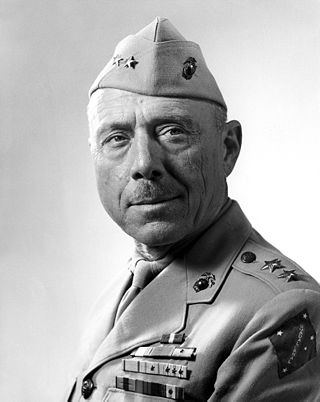
William Henry Rupertus was a major general in the United States Marine Corps, who commanded the famed 1st Marine Division in the Pacific in World War II and also authored the USMC Rifleman's Creed.
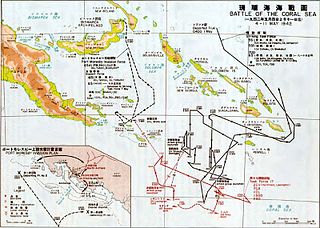
Operation Mo or the Port Moresby Operation was a Japanese plan to take control of the Australian Territory of New Guinea during World War II as well as other locations in the South Pacific. The goal was to isolate Australia and New Zealand from the Allied United States.
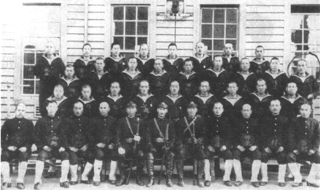
The invasion of Tulagi, on 3–4 May 1942, was part of Operation Mo, the Empire of Japan's strategy in the South Pacific and South West Pacific Area in 1942. The plan called for Imperial Japanese Navy troops to capture Tulagi and nearby islands in the British Solomon Islands Protectorate. The occupation of Tulagi by the Japanese was intended to cover the flank of and provide reconnaissance support for Japanese forces that were advancing on Port Moresby in New Guinea, provide greater defensive depth for the major Japanese base at Rabaul, and serve as a base for Japanese forces to threaten and interdict the supply and communication routes between the United States and Australia and New Zealand.
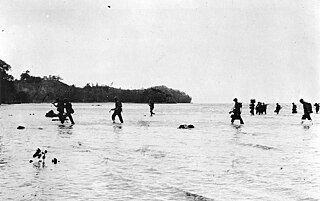
The Battle of Tulagi and Gavutu–Tanambogo was a land battle of the Pacific campaign of World War II, between the forces of the Imperial Japanese Navy and Allied ground forces. It took place 7–9 August 1942 on the Solomon Islands, during the initial Allied landings in the Guadalcanal campaign.

The British Solomon Islands Protectorate Defence Force (BSIPDF) was a British Colonial Auxiliary Forces unit raised in the British Solomon Islands during World War II. It was created following the outbreak of war with the Empire of Japan in 1942 and disbanded in 1946. The Solomon Islands has not maintained a military force since independence from British colonial rule in 1976, relying upon the Royal Solomon Islands Police Force for internal security.
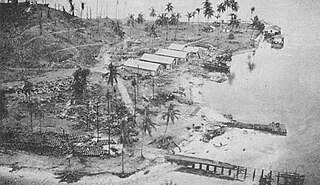
Tanambogo is a small island in the Central Province of Solomon Islands in the Nggela Islands group, which was also known as the Florida Islands under the British Solomon Islands Protectorate and during World War 2.

The Japanese destroyer Kikuzuki was one of twelve Mutsuki-class destroyers built for the Imperial Japanese Navy (IJN) during the 1920s. During the Pacific War, she participated in the Battle of Guam in December 1941 and the New Guinea and Solomon Islands Campaigns in 1942. Kikuzuki was destroyed during the invasion of Tulagi in May.

The Yokohama Air Group was an aircraft and airbase garrison unit of the Imperial Japanese Navy Air Service during the Pacific campaign of World War II.
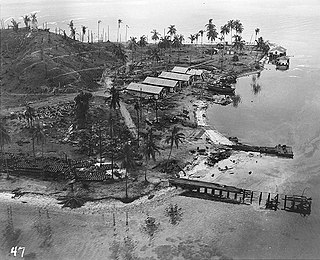
RAAF Tanambogo was a Royal Australian Air Force seaplane advanced operating base on the islands of Tanambogo, Gaomi and Gavutu, British Solomon Islands, constructed in 1939. Tanambogo and Gavutu were connected by causeway.
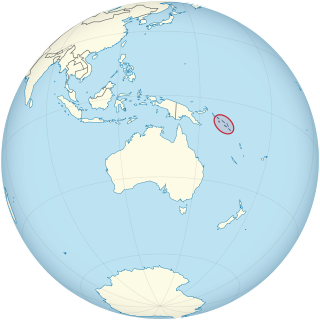
US Naval Base Solomons was a number of United States Navy bases in the Solomon Islands in the Pacific Ocean. Most were built by the US Navy Seabees, Naval Construction Battalions, during World War II as part of the Pacific War. In August 1942 the United States Armed Forces took the Guadalcanal in the Solomon, in the Battle of Guadalcanal. US Navy Seabees built a new base at Guadalcanal, Naval Base Guadalcanal and then on other islands in the Solomons.

